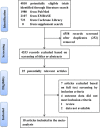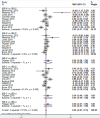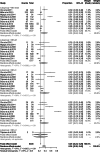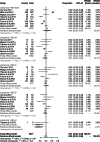The level and prevalence of depression and anxiety among patients with different subtypes of irritable bowel syndrome: a network meta-analysis
- PMID: 33413140
- PMCID: PMC7791666
- DOI: 10.1186/s12876-020-01593-5
The level and prevalence of depression and anxiety among patients with different subtypes of irritable bowel syndrome: a network meta-analysis
Abstract
Background: Irritable bowel syndrome (IBS) is a very common functional bowel disorder. However, the difference of depression and anxiety comorbidities among different IBS subtypes is still not well evaluated. This study aims to investigate the difference in the level and prevalence of depression and anxiety among healthy controls and patients with different subtypes of IBS.
Methods: PubMed, EMBASE and the Cochrane library were searched systematically until August 17, 2020. Studies that investigated depression and/or anxiety levels or prevalence among different IBS-subtype patients measured at baseline or the same point were included. Network meta-analysis was conducted to analyze standardized mean difference (SMD) of anxiety and depression levels, and single arm meta-analysis was performed for prevalence of anxiety and depression among different IBS subtypes.
Results: Eighteen studies involving 7095 participants were included. Network meta-analyses results showed healthy controls had a lower level of depression than IBS with mixed symptoms of constipation and diarrhea (IBS-M) [SMD = - 1.57; 95% confidence interval (CI) - 2.21, - 0.92], IBS with constipation (IBS-C) (SMD = - 1.53; 95% CI - 2.13, - 0.93) and IBS with diarrhea (IBS-D)(SMD = - 1.41; 95% CI - 1.97, - 0.85), while no significant difference was found between IBS unclassified (IBS-U) and healthy controls (SMD = - 0.58; 95% CI - 2.15, 1.00). There was also no significant difference in the level of depression among different IBS subtypes patients. The results of anxiety were similar to depression. Ranking probability showed that IBS-M was associated with the highest level of depression and anxiety symptoms, followed by IBS-C/IBS-D and IBS-U. Single-arm meta-analysis showed IBS-C had the highest prevalence of depression (38%) and anxiety (40%), followed by IBS-D, IBS-M and IBS-U.
Conclusion: The results indicated that IBS-M was more likely to be associated with a higher level of depression and anxiety, and the prevalence of depression and anxiety in IBS-C was highest. The psychological screening and appropriate psychotherapy are needed for patients with IBS-C, IBS-D and IBS-M instead of IBS-U.
Keywords: Anxiety; Depression; Irritable bowel syndrome; Meta-analysis.
Conflict of interest statement
All authors have no potential competing interests relevant to this article.
Figures










Similar articles
-
The Increased Level of Depression and Anxiety in Irritable Bowel Syndrome Patients Compared with Healthy Controls: Systematic Review and Meta-analysis.J Neurogastroenterol Motil. 2017 Jul 30;23(3):349-362. doi: 10.5056/jnm16220. J Neurogastroenterol Motil. 2017. PMID: 28672433 Free PMC article. Review.
-
Systematic review with meta-analysis: the prevalence of anxiety and depression in patients with irritable bowel syndrome.Aliment Pharmacol Ther. 2019 Jul;50(2):132-143. doi: 10.1111/apt.15325. Epub 2019 Jun 3. Aliment Pharmacol Ther. 2019. PMID: 31157418
-
Irritable bowel syndrome subtypes: Clinical and psychological features, body mass index and comorbidities.Rev Esp Enferm Dig. 2016 Feb;108(2):59-64. doi: 10.17235/reed.2015.3979/2015. Rev Esp Enferm Dig. 2016. PMID: 26838486
-
Comparison of comorbid depression between irritable bowel syndrome and inflammatory bowel disease: A meta-analysis of comparative studies.J Affect Disord. 2018 Sep;237:37-46. doi: 10.1016/j.jad.2018.04.111. Epub 2018 May 4. J Affect Disord. 2018. PMID: 29758449
-
Burden of anxiety and depression among hospitalized patients with irritable bowel syndrome: a nationwide analysis.Ir J Med Sci. 2023 Oct;192(5):2159-2166. doi: 10.1007/s11845-022-03258-6. Epub 2023 Jan 3. Ir J Med Sci. 2023. PMID: 36593438
Cited by
-
Exploring the burden of irritable bowel syndrome among university students in Saudi Arabia: A study on prevalence, psychological associations, and well-being.Medicine (Baltimore). 2024 May 10;103(19):e38099. doi: 10.1097/MD.0000000000038099. Medicine (Baltimore). 2024. PMID: 38728477 Free PMC article.
-
Anxiety and Depression in Children with Irritable Bowel Syndrome-A Narrative Review.Diagnostics (Basel). 2025 Feb 11;15(4):433. doi: 10.3390/diagnostics15040433. Diagnostics (Basel). 2025. PMID: 40002584 Free PMC article. Review.
-
Rome Foundation Working Team Report on overlap in disorders of gut-brain interaction.Nat Rev Gastroenterol Hepatol. 2025 Apr;22(4):228-251. doi: 10.1038/s41575-024-01033-9. Epub 2025 Jan 27. Nat Rev Gastroenterol Hepatol. 2025. PMID: 39870943 Review.
-
Studies on irritable bowel syndrome associated with anxiety or depression in the last 20 years: A bibliometric analysis.Front Public Health. 2022 Aug 15;10:947097. doi: 10.3389/fpubh.2022.947097. eCollection 2022. Front Public Health. 2022. PMID: 36045729 Free PMC article.
-
Mental Health Symptom Reduction Using Digital Therapeutics Care Informed by Genomic SNPs and Gut Microbiome Signatures.J Pers Med. 2022 Jul 28;12(8):1237. doi: 10.3390/jpm12081237. J Pers Med. 2022. PMID: 36013186 Free PMC article.
References
Publication types
MeSH terms
LinkOut - more resources
Full Text Sources
Other Literature Sources

